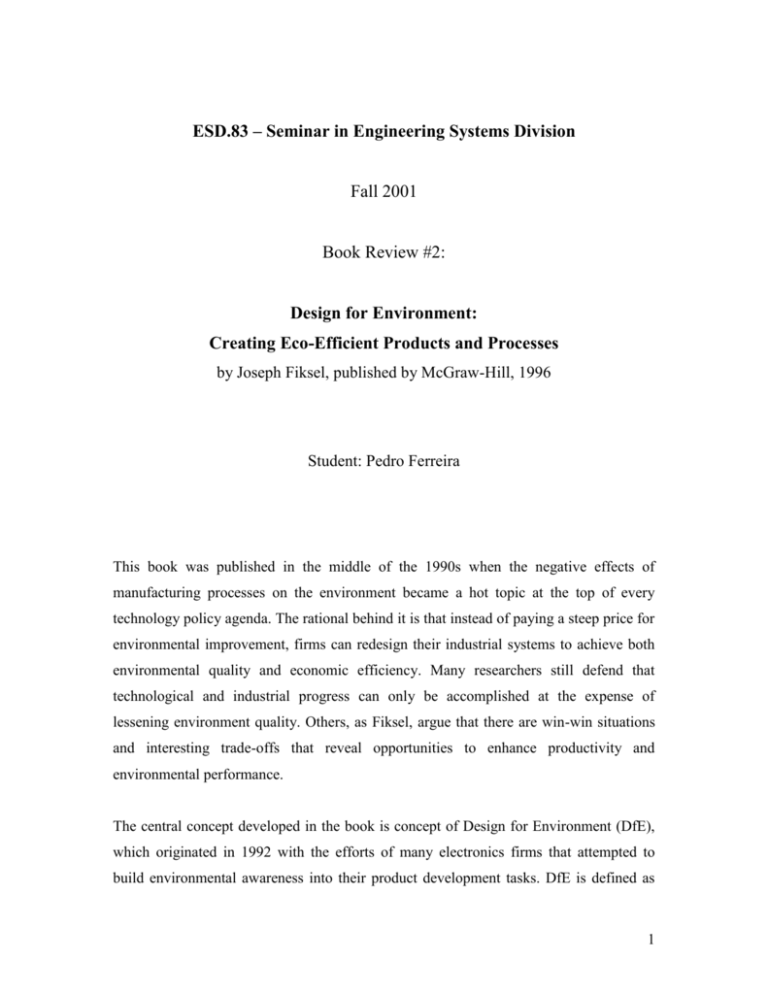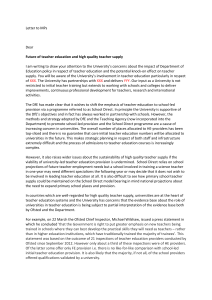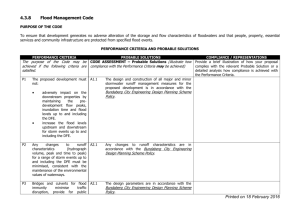Creating Eco-Efficient Products and Processes
advertisement

ESD.83 – Seminar in Engineering Systems Division Fall 2001 Book Review #2: Design for Environment: Creating Eco-Efficient Products and Processes by Joseph Fiksel, published by McGraw-Hill, 1996 Student: Pedro Ferreira This book was published in the middle of the 1990s when the negative effects of manufacturing processes on the environment became a hot topic at the top of every technology policy agenda. The rational behind it is that instead of paying a steep price for environmental improvement, firms can redesign their industrial systems to achieve both environmental quality and economic efficiency. Many researchers still defend that technological and industrial progress can only be accomplished at the expense of lessening environment quality. Others, as Fiksel, argue that there are win-win situations and interesting trade-offs that reveal opportunities to enhance productivity and environmental performance. The central concept developed in the book is concept of Design for Environment (DfE), which originated in 1992 with the efforts of many electronics firms that attempted to build environmental awareness into their product development tasks. DfE is defined as 1 the “systematic consideration of design performance with respect to environmental, health, and safety objectives over the full product and process life cycle.” The driving forces behind DfE include the fact that costumers have become increasingly concerned about the environmental friendliness of the products they acquire. In addition, the International Organization for Standardization (ISO) has developed ISO 14000 standards for environmental management systems and many government agencies took aggressive steps to assure that manufacturers are responsible for recovery of products and materials at the end of their useful lives. Similar efforts have been put forward by consortia as the Global Environmental Management Initiative and the Business Council for Sustainability Development. As Finksel points out “DfE is at the crossroads of two trusts that are transforming the nature of manufacturing in the world”, and this is what makes this concept interesting from a systems thinking perspective. DfE combines and results from the interaction between two systems, the economics system and the environmental system and branches out into two areas of action: sustainable development, which aims at designing industrial progress that “meets the needs of the present without compromising the ability of future generations to meet their own needs”; and enterprise integration, which is concerned with factoring environmental concerns into the profitability and effectiveness of the firm. Sustainable development is a statement more related to a macro view of the industrial world, whereas enterprise integration is more concerned about how to develop and integrate sustainability requirements at the micro level. This is illustrated in Figure 1. 2 “Macro Side” “Micro Side” Sustainable Development tal Pollution Prevention ge Integrated Product Development Ed Total Quality Management en nm on Ec Design for Environment ro vi En e g Ed ic om Enterprise Integration Environmental Stewardship Figure 1- Conceptualizing Design for Environment (DfE) (Adapted from Fiksel, 96). DfE results from the combination of economic and environmental performance and branches out to areas of research: sustainable development that takes a macro view of the problem and enterprise integration that deals with implementing DfE at the micro level. Once the premise of DfE is understood, the big challenge relies on its implementation. Barriers to this process are the lack of expertise among product development engineers to take into account environmental concerns, the complexity of environmental phenomena, which makes it difficult to build “systems dynamics” type of models to understand them and the fact that the economic environment in which products are produced and used is much more complex and difficult to control than the products themselves. Finksel’s book sheds light into these issues. The second part of the book is more associated with the first difficulty referred above and is instructive about how one can look and adapt product development to environmental concerns. The third part of the book addresses the other two challenges presenting a series of cases studies that serve as a reference to successfully implement DfE. There is also an introductory part, which makes the case for environmental concerns, and a fourth part that assembles a set of 3 suggestions for the future. The structure of the book is depicted in Figure 2 along with a timeline that one can associate to its contents. CHALLENGES Need to build skills to factor environmental concerns into product design Need to understand the complexity of the environmental and economic systems at the firm level BOOK CONTENTS TIMELINE The case for environmental concerns Early 1990s Formalizing DfE Snapshots of successful stories Roadmap for the near future Late 1990s 21st Century Figure 2- The main challenges to implementing DfE and an index of the contents of the book that aim at addressing those concerns. A timeline associated with the structure of the book relates it to the broader context of research to accomplish eco-efficiency. The second part of the book includes chapters that formalize the principles of DfE, chapters on how to integrate DfE into more comprehensive life-cycle management strategies and chapters about metrics for assessing environmental performance and improvement. From a systems thinking perspective these chapters deal mostly with the question of where one should draw the boundary of the system when talking about product development. This is clear from the effort of building up metrics for performance that take into account environmental variables and factoring these into the manufacturing processes. In other words, the boundary of the system is placed allowing for retrofitting the externalities of both the manufacturing processes and the manufactured products on the environment into the design of the product development process. In fact, the issue of placing the boundary of the system is directly addressed in the book by David Cohan in chapter 10, page 127, when he introduces the concept of Integrated Life-Cycle Management (ILCM): “the essence of ILCM is to focus explicitly on the real decisions firms make and on the specific economic and environmental performance metrics that are used to evaluate these business choices, while defining the life-cycle boundary in a way that is meaningful to the firm’s decisions.” 4 Central to ILCM is the idea of Life-Cycle Cost Management (LCCM) and definition the life-cycle cost as the sum of the cost of acquisition and the cost of use with the cost of disposal and post-disposal. This is the mechanism that society, and particularly the government, uses to take care of the problem: penalize someone for environment degradation and that someone will have a “stimulus ”to do something about it. Furthermore, making firms responsible for their own waste does not seem a bad idea in the first place because it punishes firms proportionally to the negative effects they cause. Left with this equation, the reader can think of environmental concerns as a source of increased costs. But Fiksel unravels the mystery of the win-win situations with a series of real world examples, which he calls “Pioneer Stories”. The books presents 11 stories of successful applications of DfE, in chapters written by invited people from companies spanning from the computer industry, to telecommunications, semiconductor, gas and electricity, healthcare, beverages and chemicals. This broad choice of industries is not by accident. Clearly, Fiksel also tries to make the case for eco-efficiency by showing that win-win scenarios are not specific to a particular manufacturing process of product but rather apply to every corner of the economy. These chapters are very similar in spirit. For example, chapter 14 looks at the introduction of DfE into Microelectronics and Computer Technology Corporation (MCC), based in Austin, TX and it describes how one can take spot win-win situations for the case of manufacturing a workstation. This firm conducted a study about the manufacturing process of a workstation. They focused on four areas: energy, materials, waste and water. They have found that Printed Wiring Boards (PWBs) consume a significant amount of energy and water along the manufacturing process. This study has stimulated a number of activities within MCC, within the government and in the industry at large. A roadmap providing directions for greening the electronics industry was published two years later and EPA’s Environmental Technology Initiative developed a DfE project to further study PWBs. This project compared various fabrication approaches and identified alternative technologies. 5 This is a common fact among most of the cases reported in this book: DfE often triggers technological innovation as a way to lessen negative externalities to the environment. Once firms factor costs from affecting the environment into their decision processes, savings associated with those costs usually come tied to other types of cost savings. In other words, reducing the costs associated with the environment often induces technological innovations that also cut costs in other tasks of the manufacturing process. Net benefits emerge when the benefits of reducing the overall cost structure overweight the losses of incorporating environmental related costs. This is illustrated in Figure 3. A Manufacturing Costs B Environmental Costs Figure 3- Illustration of how net benefits may be accomplished from considering environmental concerns and technological innovation. The inner circle represents the original manufacturing costs. When environmental related costs are added the total costs amount to the outer circle. But environmental concerns may trigger technological innovation that cuts costs, as represented by the dashed area. Net benefits are achieved when A is smaller than B. Conclusions Joseph Fiksel, Vice President of Decision Focus Incorporated, presents us a book that clearly makes the case for eco-efficiency. He carefully introduces the concept of Design for Environment and then cleverly drives the reader through a series of examples that show how DfE works in practice. These examples allow the reader to internalize DfE and think how it can be implemented in the systems he knows and deals with. It is no coincidence that McGraw-Hill dubs this book as an essential working tool for executives, managers and engineers and writes in the cover “Proven methods for developing products and processes that are profitable and environmentally sound.” 6 DfE is a concept that results from the crossroads between environmental concerns and economic performance. By definition, it is rooted in an integrated view of more than one system. It combines and discusses the societal implications of environmental quality, technological innovation for cleaner manufacturing processes and products and the economic efficiency of such changes. DfE is indeed a concept of the 1990s, a decade in which multi-systems perspectives and interdisciplinarity became major thrusts in the way people think, discuss and understand the world. This book is far ahead of others discussed in the scope of this course (ESD.83). It inherits a systems thinking rational from previous experiences and steps ahead by focusing on how to implement such a perspective. It assumes the good faith of the systems integrated approach and departs from it to define DfE. The author does not struggle with turning the setting for the book into a systems perspective because it is embedded in the definition of DfE and, in principle, in the reader’s mind. This is a very interesting book, very well organized and with a broad scope for application. The inclusion of such a diversified pool of successful DfE case studies is powerful and distinguishes it from other texts on the subject that only formalize the concept of DfE using narrow theoretical frameworks. For further research on DfE, the hyperlink http://www.meceng.uct.ac.za/~mec450z/enviro/dfe/dfe.htm gathers a significant amount of information and a number of pointers on this topic. 7





